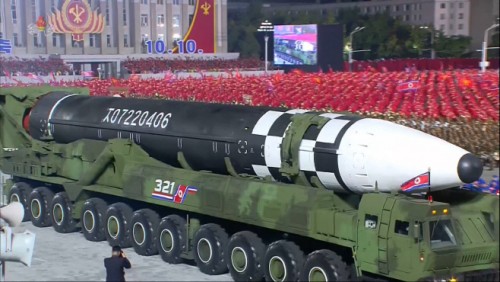 |
| North Korea fired an intercontinental ballistic missile (ICBM) on March 24, 2022. Captured from Korean Central Television footage on Oct. 10, 2020, the image is North Korea’s new ICBM displayed during a military parade held in Pyongyang to mark the 75th founding anniversary of the ruling Workers’ Party./ Source: Yonhap News |
AsiaToday reporter Lee Seok-jong
North Korea abandoned a self-imposed moratorium on long-range missile tests Thursday. The North fired what is believed to be an intercontinental ballistic missile (ICBM) for the first time since November 2017, from the Sunan airfield in Pyongyang. In response, South Korea fired multiple missiles.
The Joint Chiefs of Staff (JCS) said it detected the North Korean projectile that took off from the Sunan area in Pyongyang toward the East Sea at around 2:34 p.m. on Thursday. It explained that the projectile reached an altitude of over 6,200 kilometers and traveled nearly 1,080 kilometers, flying for at least 70 minutes. The intelligence authorities of South Korea and the United States are conducting a detailed analysis.
The military authorities said it appears to have been a new type of ICBM considering its launch point, altitude and flight distance.
They say the missile could travel 15,000 kilometers and potentially reach the continental United States if the North fires at a normal angle.
Shortly after the launch, South Korea’s JCS chairman Ge. Won In-choul and Gen. Paul LaCamera, the commander of the South Korea-U.S. Combined Forces Command, held a virtual meeting and pledged to maintain the allies’ firm defense readiness posture.
In addition, the South Korean military responded with its own missile tests to deter further North Korean provocations. At 4:25 p.m., South Korea conducted missile tests from the air, land and sea.
The exercise, including a Hyunmoo II ground-to-ground missile and one Army Tactical Missile System (ATACMS) as well as a Haesung II ship-to-ground missile and two JDAM air-to-surface missiles, showed the South Korean military’s capabilities and will to react, according to the JCS.
“It has been confirmed that in case of North Korea’s missile launch, we have the ability and posture to precisely strike the origin of the missile launch and command and support facilities at any time,” an official from the JCS said.
President Moon Jae-in convened the National Security Council (NSC) shortly after the missile launch and strongly condemned North Korea’s latest launch, saying the North broke a moratorium on ICBM tests that “State Affairs Commission Chairman Kim Jong-un promised to the international community.”
“The launch not only poses a serious threat to the Korean Peninsula, the region, and the international community, but also clearly violates U.N. Security Council resolutions,” Moon said. Noting the launch came at a time of government transition in South Korea, Moon ordered officials to explore all countermeasures while cooperating closely with related countries and the international community based on the firm Korea-U.S. alliance. The president also instructed officials to work closely with the office of President-elect Yoon Suk-yeol.
The transition team of President-elect Yoon Suk-yeol also strongly condemned North Korea’s firing of an ICBM, saying it was “a serious provocation that threatens our security.”
The team stressed the need to strongly deal with the North by cooperating with the international community based on thorough cooperation between Seoul and Washington.
It also urged the Moon Jae-in administration to come up with firm measures against the North’s threats and secure the country’s public safety.
#North Korea #ICBM #provocation #missile #moratorium
Copyright by Asiatoday
Most Read
-
1
-
2
-
3
-
4
-
5
-
6
-
7





















